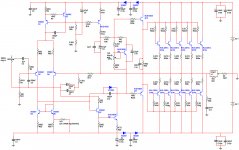I believe it was just noise. When I switch the scope to average mode and zoom in, I don't see signs of oscillations.
Attached are traces of 1 khz square wave at full scale and zoomed in without averaging and with averaging turned on.
I've been playing music with with it and and am very happy with the performance.
Hi radioFlash-
Two more things you could try if you haven't already to settle the matter. Look at the amp output at the highest sensitivity setting on your scope with the signal generator connected but no signal being output. Then disconnect the generator, short the input jack to the amp and look for changes in the trace. Also look at the generator output itself (no amp) for signs of noise on it's square wave output.
This depends on how good is your supply
If you supply is weak and the first bass tone the voltage drop to 60 volts..then no problems.
But if you supply is really strong...and bass tones gonna reduce to 69 volts..then you should never connect small impedances as 4 ohms and 2 ohms in your amplifier.
Alll depends on your supply...how strong it is...or how weak it is.
I do suggest, if you are using "L" shape adaptors, to use 8 ohms anyway.
regards,
Carlos
If you supply is weak and the first bass tone the voltage drop to 60 volts..then no problems.
But if you supply is really strong...and bass tones gonna reduce to 69 volts..then you should never connect small impedances as 4 ohms and 2 ohms in your amplifier.
Alll depends on your supply...how strong it is...or how weak it is.
I do suggest, if you are using "L" shape adaptors, to use 8 ohms anyway.
regards,
Carlos
One of the reasons I was looking at this amp was because of the number of outputs in hopes that it could be used with Higher voltage. Is it possible to run this amp on +/-75V rails with some minor changes?
Thanks, Terry
Hi Terry,
My amp is running at -/+73 VDC, no issue so far
BR,
Junie
One of the reasons I was looking at this amp was because of the number of outputs in hopes that it could be used with Higher voltage. Is it possible to run this amp on +/-75V rails with some minor changes?
Thanks, Terry
Like others I run mine on 70+ volts. have had no troubles at that voltage. It will run warmer so use good size heatsinks.
Thanks guys. So are your transformers approximately 55-0-55Vac before rectification?
Thanks, Terry
56-0-56 for mine. Only change was to use 100v filter caps. Had made other changes previously as stated in earlier posts but they aren't relevant to the rails voltage issue.
Not needed to match Ranchu
Try to match the small ones at the input.
We use to buy several transistors and measure the gain..then we select the ones have lesser differences in gain... the gain i am refering too is the one you measure in cheap multimeters that has a socket for this kind of measurement.
PNP and NPN transistors, even being complementary, use to have different gain...usually PNP shows higher gain compared to the NPNs counterpart... at least this happened these last 50 years..i am not sure if they fixed that ... i do think the difference remain considering the ones i have at home.
The consequence of the used of unmatched parts appear mainly in the power amplifier output...there you gonna have some of set milivolts...this is not a real problem.... famous factories accept 25 milivolts as normal and standard.....in the real world, even 200 milivolts ( a huge off set) represents 10 miliwatts into 4 ohms speakers..this does not move speaker and does not produce thump when you connect the speakers and disconnect them from the amplifier.
Power on thump is due to the time needed to charge condensers in the input circuitry... there, when you switch power on, they start to charge and while charging the voltage appear variating in a ramp way..increasing fast...and due to that you see the result as some kind of unstability that pushes your woofer forward or backward...usually this does not harm unless you are using under rated speakers that cannot face this job.
Unmatched transistors, double differential and these kind of amplifiers (leach style and others), because of this difference in gain into NPN and PNP transistors, use to generate harmonics..... and harmonics generated are understood as distortion.... harmonic distortion...some guys loves the result..uncle charlie does not like...i do not use double differential circuits..due to that limitation to find matched NPN to PNP..something factories can do, but we, normal users, have troubles to order really matched counterparts.
Take some of your time to read our forum.... i mean.... the entire forum...since 2004.... several threads teaches us a lot..including this stuff i am repeating to you now...something i have published many times...also many guys did the same..... read the forum will make you an expert, because the good guys in audio are all united in this diyaudio forum..including the big shots...the great Doctors, the ones write books and work in important factories as circuit designers.
That's the reason why Dx amplifiers does not use double differential using complementary transistors...exactly because this difference in gain i avoid the tophology...Dx amplifiers builder does not suffer from this kind of problem.
Meanman is Dx Corporation too... authorized to distribute Dx MKIII pcboards.
regards,
Carlos
Try to match the small ones at the input.
We use to buy several transistors and measure the gain..then we select the ones have lesser differences in gain... the gain i am refering too is the one you measure in cheap multimeters that has a socket for this kind of measurement.
PNP and NPN transistors, even being complementary, use to have different gain...usually PNP shows higher gain compared to the NPNs counterpart... at least this happened these last 50 years..i am not sure if they fixed that ... i do think the difference remain considering the ones i have at home.
The consequence of the used of unmatched parts appear mainly in the power amplifier output...there you gonna have some of set milivolts...this is not a real problem.... famous factories accept 25 milivolts as normal and standard.....in the real world, even 200 milivolts ( a huge off set) represents 10 miliwatts into 4 ohms speakers..this does not move speaker and does not produce thump when you connect the speakers and disconnect them from the amplifier.
Power on thump is due to the time needed to charge condensers in the input circuitry... there, when you switch power on, they start to charge and while charging the voltage appear variating in a ramp way..increasing fast...and due to that you see the result as some kind of unstability that pushes your woofer forward or backward...usually this does not harm unless you are using under rated speakers that cannot face this job.
Unmatched transistors, double differential and these kind of amplifiers (leach style and others), because of this difference in gain into NPN and PNP transistors, use to generate harmonics..... and harmonics generated are understood as distortion.... harmonic distortion...some guys loves the result..uncle charlie does not like...i do not use double differential circuits..due to that limitation to find matched NPN to PNP..something factories can do, but we, normal users, have troubles to order really matched counterparts.
Take some of your time to read our forum.... i mean.... the entire forum...since 2004.... several threads teaches us a lot..including this stuff i am repeating to you now...something i have published many times...also many guys did the same..... read the forum will make you an expert, because the good guys in audio are all united in this diyaudio forum..including the big shots...the great Doctors, the ones write books and work in important factories as circuit designers.
That's the reason why Dx amplifiers does not use double differential using complementary transistors...exactly because this difference in gain i avoid the tophology...Dx amplifiers builder does not suffer from this kind of problem.
Meanman is Dx Corporation too... authorized to distribute Dx MKIII pcboards.
regards,
Carlos
Last edited:
Thanks for the explanation Destroyer... I am slowing working my way through the forum posts but looking for the right information in 100s of pages of forum posts is like looking for a needle in a haystack.
I am not complaining because I'm enjoying it all.
Also I have bought some MKIII boards from Meanman in his latest group buy.
I am not complaining because I'm enjoying it all.
Also I have bought some MKIII boards from Meanman in his latest group buy.
I have receive 2 complaints about these pcboards
well... 2 complaints is nothing or half of anything...but we have to listen everybody.
They say holes are not correct..there are some holes to insert component leads that are not fine...people have to open the hole diameter.
I would like you to inform this stuff in order to ask Meanman to fix, as he is the one is already producing these pcboards.
Maybe the guy is trying to use non standard parts....so...i am asking YOU... people that is assembling or have assembled to help US to fix the stuff.
regards,
Carlos
well... 2 complaints is nothing or half of anything...but we have to listen everybody.
They say holes are not correct..there are some holes to insert component leads that are not fine...people have to open the hole diameter.
I would like you to inform this stuff in order to ask Meanman to fix, as he is the one is already producing these pcboards.
Maybe the guy is trying to use non standard parts....so...i am asking YOU... people that is assembling or have assembled to help US to fix the stuff.
regards,
Carlos
A question to those to have built a MkIII...
How do you match the output transistors??
ESP has provided a nice article describing how to match transistors:
Matching Power and Driver Transistors
I have the 100R resistors soldered (changes from 22R to 100R) R23B R23A and the bias set to 25mv.
I also changes the 180pf to 100pF silver mica capacitors for C10 see schema.
My conclusion is the 180pF silver mica sound better than 100pf.
I continue not post further details about the sound, please let me know what you all find from this change.
Am very curious if anyone else would like to test this out.
Regards,
Rudy
I also changes the 180pf to 100pF silver mica capacitors for C10 see schema.
My conclusion is the 180pF silver mica sound better than 100pf.
I continue not post further details about the sound, please let me know what you all find from this change.
Am very curious if anyone else would like to test this out.
Regards,
Rudy
Attachments
Last edited:
I have the 100R resistors soldered (changes from 22R to 100R) R23B R23A and the bias set to 25mv.
I also changes the 180pf to 100pF silver mica capacitors for C10 see schema.
My conclusion is the 180pF silver mica sound better than 100pf.
I continue not post further details about the sound, please let me know what you all find from this change.
Am very curious if anyone else would like to test this out.
Regards,
Rudy
Hi Rudy-
I have tried 180, 120 and 100pf for C10. I can't hear any significant change in the amps sound. Have you listened to two amps with different C10 values at the same time? That's a comparison I haven't made. How would you describe the difference? Theory says the smaller value for C10 should give a higher slew rate but that may not be audible under normal circumstances. I haven't encountered any stability issues with the smaller cap which is the other potential risk of using it.
Steve
- Status
- Not open for further replies.
- Home
- Amplifiers
- Solid State
- Dx Blame MKIII-Hx - Builder's thread

